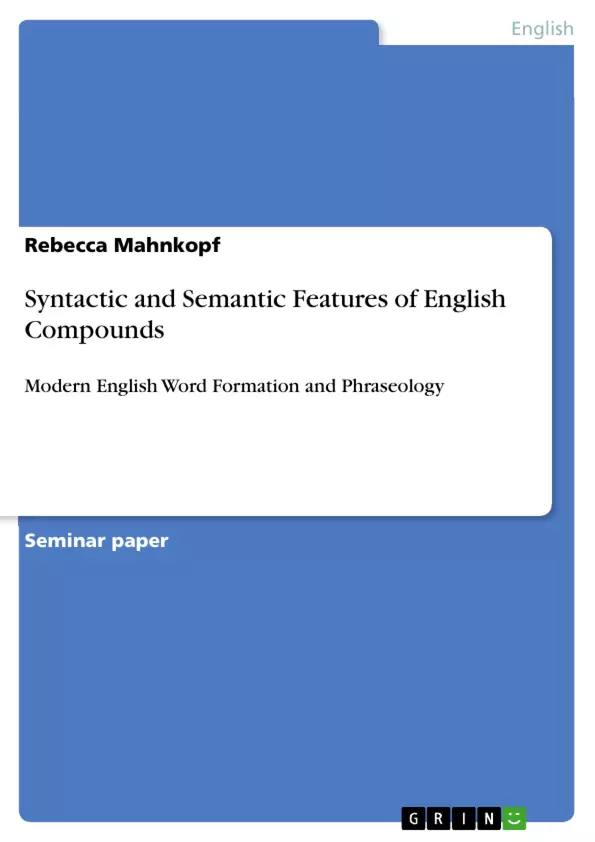Compounding is a very productive word formation process. Productivity is “one of the defining features of human language which allows a native speaker to produce a large number of words and sentences according to the rules of a generative grammar” (Bauer 1991:84).
In the English language there exists a vast number of words which were produced by compounding.
In my term paper I am going to explain in detail what we understand by the term compound. I am going to look at semantic and syntactic characteristics and how compounds can be distinguished from syntagms which look very similar to them.
In the further progress of my manuscript I am going to make a pilot study of the frequency of compounds in newspaper articles from different genres. I give answer to the question which genre seems to favour the use of compounds and which not. Of course my study is not going to be sufficient enough to present generally accepted results but after it prospects can be estimated.
Inhaltsverzeichnis (Table of Contents)
- Introduction
- General characteristics of compounds
- Definition
- Compounds vs. syntactic groups
- Difference between compounds and syntagms according to meaning
- Difference between compounds and syntagms according to syntactic structure / sequence of elements
- Difference between compounds and syntagms according to stress
- Difference between compounds and syntagms according to spelling
- Compounds vs. derivations
- Types of compounds
- Frequency of compounds in newspaper articles and other texts
- Pilot study of newspaper articles from different genres with regard to the semantic types of compounds in the texts
- Conclusion (Evaluation of the frequency analysis)
Zielsetzung und Themenschwerpunkte (Objectives and Key Themes)
This term paper aims to provide a detailed explanation of the term 'compound' in the English language. The paper focuses on exploring the semantic and syntactic characteristics of compounds and how they can be distinguished from similar-looking syntactic groups. It also examines the frequency of compounds in various genres of newspaper articles, aiming to determine which genres favor their use. Key themes include:- Defining and characterizing English compounds
- Distinguishing compounds from syntactic groups and phraseologisms
- Analyzing the semantic and syntactic structures of compounds
- Investigating the frequency of compounds in different genres of newspaper articles
- Exploring the relationship between genre and compound usage
Zusammenfassung der Kapitel (Chapter Summaries)
Introduction
This chapter introduces the concept of compounding as a productive word-formation process in the English language. It highlights the significance of compounding in creating a vast vocabulary and provides an overview of the paper's objectives and research focus.General characteristics of compounds
This section delves into the definition of compounds, explaining how they are formed by combining two or more word stems into a single unit. It discusses the grammatical and semantic functions of compound elements and explores the different types of compounds based on their structure and meaning.Compounds vs. syntactic groups
This chapter addresses the challenges of distinguishing compounds from syntactic groups, which often share similar appearances. It outlines four key criteria for differentiating them: meaning, syntactic structure, stress, and spelling. Each criterion is examined in detail, providing examples to illustrate the distinctions.Frequency of compounds in newspaper articles and other texts
This chapter explores the prevalence of compounds in different types of texts, particularly newspaper articles. It discusses the factors that might influence the frequency of compound usage in various genres and sets the stage for the pilot study presented in the next chapter.Pilot study of newspaper articles from different genres with regard to the semantic types of compounds in the texts
This chapter presents a pilot study examining the use of compounds in different genres of newspaper articles. It analyzes the types of compounds found in each genre and explores the potential relationship between genre and the preference for specific compound types.Schlüsselwörter (Keywords)
This paper focuses on the key concepts of **compound formation, syntactic and semantic features, compound vs. syntagm, word formation process, frequency analysis, genre analysis, and newspaper articles.** These keywords represent the core themes and research areas investigated in the study.- Quote paper
- Rebecca Mahnkopf (Author), 2004, Syntactic and Semantic Features of English Compounds, Munich, GRIN Verlag, https://www.grin.com/document/189408



